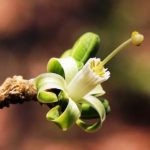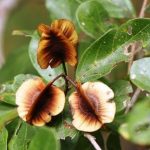TREE LIFE.
November, 1994,
Our presentation to Mr. Thom Muller. This eagerly awaited event takes place on Saturday 12TH November at Chapungu Village at 1630 for 1700 hours. We expect a good turn out and are therefore pleased to have the use of the thatched shelter where tea, coffee, wine, beer or cool drinks will be served. Contributions of snacks for the occasion would be much appreciated. Entrance fee to Chupungu is $5 per person. Why not arrive earlier to watch some African dancing or to look around the gardens.
MASHONALAND CALENDAR
Tuesday, 1st November. Botanic Garden Walk at 1645 for 11500 hours. We will meet Tom in the public car park of the Gardens, and continue where we left off last month with Rubiaceae
Saturday 12th November. Presentation to Mr. Thom Muller at Chapungu Village Meat at 1630 for 1700 hrs.
Sunday 20th November. Barwick Kopjies. Via Dick and Judy Arnott’s Yate Fam off the Lomagundi Road. There is a lot to interest us at the base of the kopje so the climb up a gentle slope is optional.
Saturday 26th November. For Mark’s walk we return to Lyndhurst Farm where rain and cold curtailed the study of some interesting vegetation in October.
Tuesday 6th December: Botanic Garden Walk.
Sunday 11th December. This year our tree walk/Christmas get together will take place on Mazowe Citrus Estate.
MATABELELAND CALENDAR
Sunday 6th November: Inungu — Matopos. Half or all day outing. Meet at Girls’ College for a prompt 0830 hrs departure.
Sunday 4th December: Bulawayo Golf Course.
BOTANIC GARDEN WALK : 4TH October, 1994
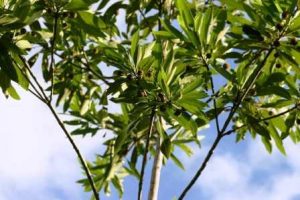
Breonadia salicina. Photo: Bart Wursten. Source: Flora of Zimbabwe
The subject on this Tuesday evening was Part 2 of RUBIACEAE. The first tree examined was Breonadia salicina (formerly Adina microcephala) In Tom’s opinion, this is one of our most beautiful trees, often a genuinely “Iarge” tree (attaining 30 metres), and-occurring in riverine vegetation at low altitudes. The leaves are in whorls of 3 to 4 and the flowers are arranged in spherical heads. The wood is exceptionally attractive, very dark, but with a greasy texture which makes it difficult to work.
Seven species of the genus Psychotria occur in Zimbabwe and we were able to look at three of them. Firstly Psychotira capensis, a shrub or tree of low altitudes. It is rather similar to P.zombamentana, however, the latter usually occurs at altitudes over 1400 metres. P.capensis occurs (for example) in the Haroni/Rusltu confluence area.
Psychotria mahonii grew nearby with very large leaves and indeed rather rambling Tabernaemontana elegans (the Toad Tree). However, that species would be easily separable in having a milky sap.
A search later for Psychotria zombamontana produced a very dried-up and miserab1e looking specimen.
Psychotria spp., like Pevetta spp., do sometimes have bacterial nodules in their leaves, which appear as black dots when held up to the light. For example the little Psychotria kirkii which occurs occasionally in the woodland around Harare does. However, none of the species seen today possess this feature.
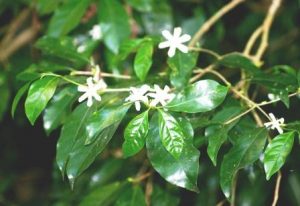
Coffea salvatrix . Photo: Bart Wursten. Source: Flora of Zimbabwe
Coffea salvatrix was just coming into flower. It grows in the Chirindu and Rusitu Forests. Tom explained that one argument for preserving these forests was the economic one that these wild species of coffee may eventually prove to be of commercial value.
On to a spectacular climber, the climbing Canthium, Keetia gueinzii. This has lateral branches which are somewhat reflexed and act as aids to climbing. At the branch points, there is often a distinctive pair of rounded leaves which although they look a little like a very prominent pair of stipules are in fact not, the true stipules being present and very much smaller. This species possesses an orange slash and can be a very large liane. It is common at wide range of altitudes. (300m to 1800m ).
Another species which has a similar pair of leaves at the branching points is Cremaspora triflora.
Finally, we found the rather elusive Aidia micrantha . This is never a climber but is usually a shrub or a low multi—trunked tree. It occurs mainly-at low altitudes (e.g. Haroni/Rusitu) but has been found by Tom at 1300m at Stapleford Forest.
Once again, we thank Tom for shedding light on this rather difficult genus.
-MARK HYDE
which families can you confuse with RUBIACEAE?
The well-known one is the Mangrove family (RHIZOPHOROCEAE) which in Zimbabwe is represented by various species of Cassipourea. These have opposite leaves and stipules but the leaves are serrate, whereas RUBIACEAE leaves are entire.
In a visit to the Sanyati Communal Land (c. 850m altitude) in May, Maureen, Andy and I puzzled for ages over a climbing species growing in tangled vegetation in a dried-up stream bed. This had opposite leaves with stipules. It also had very distinctive winged fruits and despite these we had to admit defeat . Bob later identified it as Triaspis mscropteron ssp.massaensis which is in the family MALPIGHIACEAE.
LA ROCHELLE 12-15 SEPTEMBER 1994
The Tree Society’s visit to La Rochelle on 11 August was just a month too early for the sight of a fine specimen of Dombeya rotundifolia (wild pear) covered in beautiful pink flowers. It stands on one of the walking trails above, and to the west of, the main garden and it is within five or six metres of a conventionally white—flowered version of the some species. This is the only pink—flowercd D. rotundifolia I have ever seen. According to Coates Palgrave the flowers are “white, rarely pale pink” and the one I saw had somewhat deeper-than-pale shade of pink. So, off with you to La Rochelle in September 1995 and I’m sure the head gardener, Nicholas Knohiri, would be pleased to show you the tree.
For those whose eye sight does not fail them totally when confronted with exotic trees. mid-September is also flowering time for the Chinese tree, Paulownla tomentoso (Empress Tree) and what a magnificent spectacle this is with its large panioles of pale purple flowers. P.tomentosa has been cultivated in China for at least 3000 years and a monograph on the species was written in 1049 BC by a man named Chen Chu. The family is SCHOPHULARIACAE which consists mainly of herbs. but Paulownia (6-10 species) is a genus of trees cultivated by the Chinese in conjunction with agricultural crops, ie agroforestry. Tree spacing usually starts off at about 6 x 6 m (about 280 per ha) and the agricultural crops or pastures are planted between the rows of trees. Alternate rows of trees are removed when they are about 5-6 years old. Paulownia wood is very light (270-350kg/cubic metre) but it is durable, easy to work, straight grained and “has a beautiful gloss like spun silk”. It is valued for cabinet work, house construction, handicrafts and especially for musical instruments.
If you wonder why I included the English names for Dombeya and Paulownia it is because I know some members of the Tree Society who are not able to take part in the Botanic Garden walks, etc., so are not very familiar with the Latin names. They have expressed their frustration at the exclusive use of Latin names in Tree Life.
-Lyn Mullin
LYNDHURST FARM 16th October, 1994
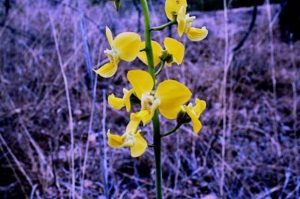
Eulophia speciosa . Photo: Mark Hyde. Source: Flora of Zimbabwe
It was a really wet day and as a result only a few hardy souls ventured out into the rain and had a very interesting walk, thanks to Mark. Despite leaking raincoats and dodging heavy drops from rain sodden branches we managed to identify some 45 species; not forgetting the little fellas – Eulophia speciosa with its spikes of yellow blooms to the pink orb – like inflorescence of Boophane disticha. Below, in the stream bed, nature’s repair work was already underway with new foliage bursting out from the heavily frosted Syzygium cordatum. The Salix subserrata seemed to have reacted to the wet conditions, most of the leaves were turned with the white underside facing the rain. Is this usual or were our eyes being tricked by the grey day?
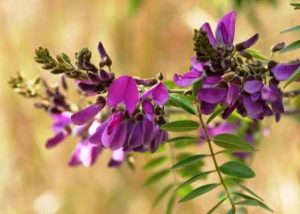
Mundulea serices. Photo: Bart Wursten. Source: Flora of Zimbabwe
Some of the other species noted were unfortunately not in flower and magnificent Schotia brachygctala on most of the anthills. For our efforts we were rewarded with the sight of several Mundulea serices covered in lilac blooms – fantastic.
After a long walk back our interest faltered and we sneaked home for some dry clothes. Many thanks to the Schotts family and we look forward to a return visit on a dry day.
(See Calendar – November 26th)
-Andy Macnaughtan
NYARUPINDA CATCHMENT OCTOBER 1994
Reference will be made to “Tree Life“ No. 176, please have it handy. You may have noticed the Southern Cross between paragraphs one and two in Nyarupinda Catchment, my thanks to the typist for copying this embellishment.
FROST Part 2 Topography and the Incidence of Frost.
At Wye College in Kent (The Garden of England) a group off us studied pomology, the culture of rosaceous fruits. The lecturer, Mr. Bagenal (Baggy), used the adjective ‘katabatic‘ which ‘pertains to a down-flowing wind cooled by radiation, as one reaching a valley from high ground. This concerns topography and the incidence of frost. In general, frost is more likely at high elevations because loss of heat by radiation increases with increase in elevation. This cold air is heavier than warm air and will remain at ground level unless there is a slope which allows it to flow to the lowest place, this results in lower temperatures in valleys and on lower slopes, frost holes occur where the cold air builds up because it cannot escape. Consequently the ideal site for planting crops be it apples, peaches, strawberries, bananas or vegetables should satisfy the following conditions: a) Site with fall to open country, b) Minimum of high land above, c) 3-way air drainage, d) Leeway to allow for cold air coming in from outside. After the crop is planted, clean cultivation is necessary because much lower temperatures occur where tall ground-cover is present, ie. bare soil heats up quickly and, due to more rapid conduction of heat keeps the air near the soil surface warmer at night, when the conditions for radiation frost exist. Cloud has an insulating effect in that heat lost by radiation is reflected back or absorbed by water particles, thus radiation frosts are unlikey under cloudy conditions. Similarly the particles in smoke and industrial haze can be useful because they prevent rapid radiation.
FROST Part 3 will summarise the cellular basis of freezing damage. In addition the following statement by Jack Hattie “….the sap in exposed vegetation will freeze” will be qualified.
These asterisks ***may now be interpreted as ice crystals.
The season of flowering trees
Ochna gambleoides flowered on September 20 when a strong wind blew all day. This beautiful sight was compensation for the long wait for a moment calm enough to take a photograph of this tree in bloom. The following day only a few petals remained, the life of its flowers may be counted in hours. Many species of indigenous trees flower when the weather is stressful – desiccating winds, drought and high temperatures often making each flower short-lived, currently there is a carpet of spent blossom of Lonchocarpus capassa. Flowering may be continuous or intermittent for many months, for example Ficus, Salix, Rothmannia (fischari in the Eastern Districts), Senna, Turraea, Protea (gaguedi), Calpurnia (planted in my garden), Faurea (speciosa) and Bauhinia petersiana. Woodland scents are not always easy to trace, this is their charm. Zanha africana In woodland beyond the garden Zanha is dormant. In the garden a male and female tree have been observed this September and October, often we are away at this time and fail to see their petal-less flowers. A few bees indicated that something was happening on the staminate tree at noon on October 11th. Here and there on the compact inflorsscences yellow anthers were just visible between the sepals. At about 6pm the sound of bees compelled me to find them. Zanha? yes. Its minute opened buds were ‘bristling’ with anthers displayed on rigid filaments, the air was heavy with scent. The change in this tree since lunch- time was most remarkable. By 6.35pm the bees had gone, brief silence until chafers arrived to attack Mfuti. Next morning, moribund flowers-and no bees. Pilstillate Zanha bloomed a few weeks too soon unless there have been hermaphrodie flowers or late female blossoms there will be no decorative wild apricots in the garden this year – time will tell….
Exceptional weather in Mid-0ctober 1994
This month’s weather will be remembered for being cold and violent; gales, hail and electrical storms. Torrential rain ruined grain and other crops. Morning temperatures were approximately 12 degrees Celsius during this sunless cloudy period. Fallen trees blocked roads and electric power failed.
The National sport Emblem of the “New” South Africa
The Protea has replaced the springbok as a symbol of strength and unity. The emblem shows obovoid stalkless leaves and flower tips elongated into a cone in the centre of the flower head. This is diagnostic of Protea magnifiga not P. cynaroides of which the diagnostic feature is the long stalk of the leaf. South Africa’s national flower is Protea gyparoides, King Protea.
(Protea Atlas Newsletter 24 September 1994)
-Benedicta Graves
Thora’s herbal remedies
Boabab – Adensonia digitata – this is one of Africa’s most magnificent, useful and interesting trees. The bark on the great bole is pinkish grey and contains a tragacanth like gum, thick with mucilage. Although bitter in taste it is used as a food by the indigenous people and used as a medicine. It brings down fevers – especially malaria. The leaf is edible – can be eaten fresh or cooked as a spinach. The tea of the latter is also used for fever, chest ailments, coughs and asthma. The leaves are used as a poultice for boils, sores and scratches. The flowers, large white and beautiful, have the unpleasant smell of lion and are not picked by man being superstitious that its counterpart will attack and devour those that destroy the flower. The fruit that follows the flowers is therefore prolific and these are much sought after by man, baboons and monkeys. The seeds are embedded in a white powdery pulp, containing tartaric acid. Hence the name Cream of Tartar. They are refreshing to suck, being thirst quenching and when soaked in water make a pleasant lemony flavoured drink that is taken to bring down fevers and relieve colds and ‘flu. The acid pith is mixed with meal to make a much relished acid porridge that is believed to make one brave and strong. The wood is salty and the ash is used to mix with food. The fresh soft fibrous wood is spongy and juicy and is chewed by buck to quench their thirst. The wood is not suitable for wood working. Paper and woven cloth are made from the flexible, fibrous inner bark.
The Mopane (Colophospernum mopane) MOTH – GONIMBRASIA – BELINA
Having just returned from South Africa, I though this very profitable home industry would be of interest. A lovely pale golden silk is being spun from the cocoons of the mopane worm. This material is also dyed in colours that blend with the gold. The cocoons are unwound just before the adult moths are ready to emerge and sufficient cocoon is left for them to complete their cycle and thus emerge, mate and lay eggs, ensuring future generations.
-THORA HARTLEY
Trees and Myths
Recently I was talking to several ex-students who are now in the tourist industry and we got on to trees of the Zambezi Valley and in particular the tamarind. It seems to me that there are certain views which are being perpetuated by our guides regarding this and other trees, and I would just like to query a few of these myths, throwing them open for discussion amongst the “fundies’ of this Society. Otherwise they are being presented as fact.
Maybe I’m barking up the wrong tree (sorry , neither pun intended). If they have been aired previously, especially by Tom Muller at the Botanic Garden, please forgive me but, as a teacher, I know repetition helps slow learners like myself.
Tamarindus indica, otherwise known as the Tamarind. ls this an indigenous tree or an escaped exotic from the East (The Indian subcontinent)? The latter view seems prevalent amongst our guides – it’s said to have been introduced by early Arab and/or Portuguese traders and gone wild. Are they misinforming the public? I understand that it may seem valid, in that these trees are locally restricted to the main waterways of the Zambezi and Luangwa. While it does provide a bit of the exotic to the minds of their clientele. however what’s the proof? A book I have on trees in India (1) declares it is indigenous there, but a Zambian publication (ii) while accepting its restriction to the main valleys, suggests “It occurs very widely in the rest of Tropical Africa and is undoubtedly indigenous.” So there are two scenarios. Was it an African tree which was discovered by people from the east and taken back there whence it has ‘indigenized’ becoming a significant element in their culinary traditions? Or was it brought originally from there for their pods and gone wild in Africa? I would like to suggest that both are myths and that we should stop perpetuating them. I wonder if like Coates Palgrave (iii), the source isn’t both areas. Looking at the book on Indian trees there are several common indigenous trees, right down to species level – Acacia nilotica, Albizia amara etc. Can’t we admit emergence in evolution. Both areas are tropical and have large numbers in the CAESALPINIACEAE family. Why do we have to invoke human agency to explain their distribution. Anyway, I call for comment, maybe we can just elaborate on what our guides say.
There are two other topics I would like to query. Both concern fictitious lines of trees, although the myths have different origins. Again I regret that they are quoted by tour guides and we are in serious danger of myth becoming accepted as ‘truth’. The fact is the line of Baohabs (Adansonia digitata) existing across the S.E. Lowveld from Great Zimbabwe to the Save/ Runde junction. It is said to result from trees sprouting up along the “Arab Traders” route. I heard a lot of this when I was based at Great Zimbabwe from the local white community. I have looked for this ‘line’ and can find no evidence of it why this myth arose I think has less to do with truth, as with the mentality of external origins to Great Zimbabwe and the fruitful imagination of early and prominent European Settlers in the area. I think Blake—Thompson formerly down in what is now Gonarezhoe is particularly to blame for this and other Arab myths. (harbours on the Save) etc. But maybe I am very wrong, just a cynical academic, and I am more than happy, in fact, would be delighted, to reconsider the evidence if there is any. The other myth line relates to Hyphaene benguellensis or ilala palm in the Hwange area. I cringed when recently I over heard a guide citing the age old tale about lines of palms marking elephant paths. As far as I can see, these lines (if they really do exist which I couldn’t establish, two trees always can make a line) mark soil and moisture specifications required by that particular plant and not animal routes. Yes, elephants might eat and deposit the fruit, but those that grow tend to correlate to other non-animal factors. I have seen fruit a long distance from the existing (suitable) locations of the palm, and these are not and have not previously grown because conditions haven’t been correct. Why is this myth perpetuated?
Anyway these are just a couple of ideas and I do hope they might arouse some reaction in the pages of True Life and that it gets through to our Tourist Trade. Scientific fact is necessary, not unsubstantiated myth.
=Rob Burrctt.
Ref: (i) -Bostock-Wood C.V.l992 Trees in Society in Rural Karngtaka, India. ODi- : i.on<ion
(ii) -Storrs, A.E.FG 1979: Know your trees. Forest Dept: Ndola.
(iii) -Coates Palgrave, K. 1977. Trees of Southern Africa Struik:
ANDY MACNAUGHTAN CHAIRMAN


